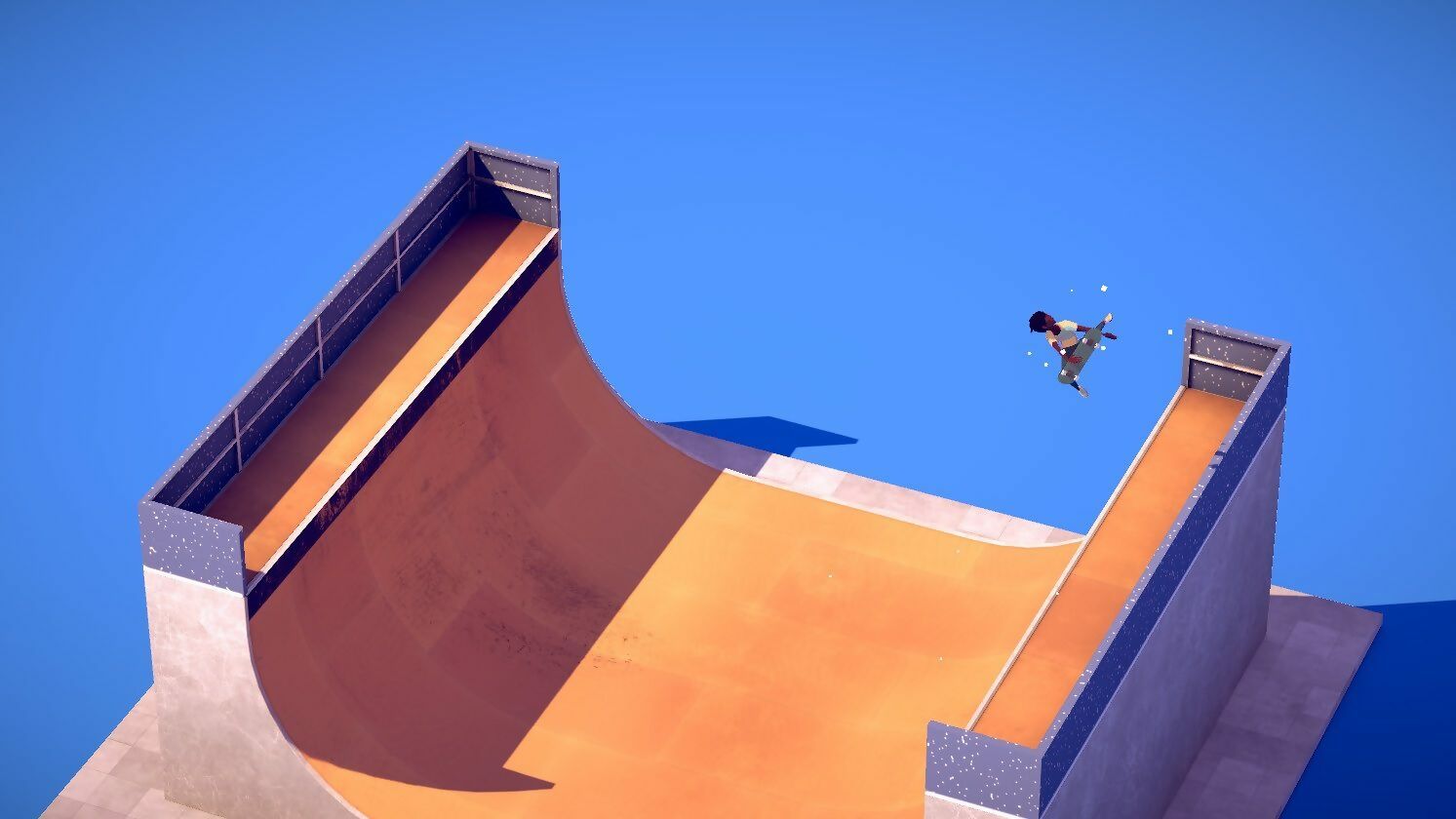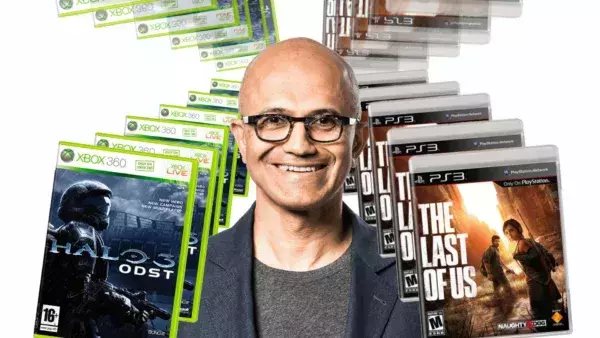
Ask any real-life skateboarder what they enjoy about the pursuit, and odds are they won’t say anything regarding score-chasing or countdown timers. It’s a wonder, then, that such metrics tend to be front and centre in a lot of triple-A skateboarding games – it’s an unfortunate side-effect of the Tony Hawk’s Pro Skater template being so successful, perhaps. That series was great at presenting the thrill and momentum of skateboarding, sure, as well as introducing the culture to a mass general audience.
One aspect it left by the wayside, though, is how soothing the act of stepping onto a board can be. Unless you’re competing in a trick contest, organised event – or now even the Olympics – skateboarding is more often solely about one person and their board. Like meditation, everything else just falls away…
It’s taken time, but suddenly a small group of indie developers has risen up to finally fill this unique gap. Their intention is to showcase skateboarding’s serener side while still making the act of kickflipping and board sliding inherently skilful and fun. One of those is Snowman, a small team of creatives that wanted to portray what it’s like to skateboard in a genuine, laid-back manner – similar to their own neighbourhood experiences growing up. The studio eventually did so by launching Skate City on iOS and Android back in 2019.
“We wanted to create an authentic take on skateboarding that captured what we thought it felt like to skate in real life, and bring that to mobile,” says Snowman’s senior producer Andrew Schimmel. “We wanted to bring the thrill of skating to more people who might have a harder time with some of the more complicated control schemes out there. The sport is naturally exciting, and a lot of people gravitate towards it, but by opening the doors to this world a little wider, we could make something anyone could enjoy.”
Taking place entirely on a 2.5D plane, Skate City challenges players to skate through various outdoor environments situated all over the world, undertaking bite-sized runs to the tune of a soothing, lo-fi beat soundtrack (this was, we’re told, “developed by friends of the development team”). Skate City differs from other skateboarding games in that it dedicates just as much focus to establishing a relaxed vibe as it does the need to perform tricks or dodge obstacles. It further instils this sense of ‘chill’ by mixing in a minimalist pastel art style and picturesque backdrops, both of which truly help you become one with the board. The result? A startlingly tranquil take on skating that manages to reward patience and skill at the same time.

Similar to Skate, Session, and Skater XL, shifting weight will be key to skateboarding successfully in Skate Story.
Skate City has since gained a new lease of life since launching on consoles earlier in 2021, but Schimmel suggests it’s the game’s mobile origins that make it so stress-free. “The environment and mood are things we feel are essential to get right in all of our games as they’re often key to standing out as a mobile experience,” he says. “We also wanted to put as much emphasis on the art style and the atmosphere in the game, as setting is often just as important to the feeling of a skate session as the tricks or obstacles are.”
Snowman and its development partners at Agens and Room8 looked at the landscape of skateboarding games and noticed something was lacking. You had games that chose to centre on physics-based controls in the effort to simulate reality while, as previously mentioned, at the opposite end of the spectrum, the Tony Hawk’s franchise had cornered the more arcade-y route. At the time, there didn’t seem to be a game that sat slap-bang in the middle.
“There was something missing for us in a lot of the games we tried in the genre,” says Schimmel. “A feeling of losing time and place in the moment [when] chasing tricks, and the sort of ambient quality you get when you’re outside doing that for hours and hours. That usually feels pretty chill, when you really start to appreciate everything around you after your heart has been pumping away.” This, combined with Skate City’s more approachable controls, ensured that players of all skill levels could efficiently tap into that subtle placidity found in-between skateboarding’s more high-wire moments.
While Snowman may have found a way to bring calm to the idea of skating through city streets, 2021 saw another indie gem inspire players by highlighting the cathartic benefits of deck riding. In this instance, heaven was quite literally a half-pipe. Developed by Berlin-based solo developer Paul Schnepf, The Ramp is an isometric skateboarding game that strips everything back, encouraging you to find your own rhythm and flow during brief skateboarding sessions. It doesn’t need lavish obstacles, complex level layouts, or online leaderboards to hold your attention. Instead, it’s about making your own small moments of fun with just you, your board, and a selection of concave ramps.

Skate City opts for a distinctive pastel colour palette to help set a tranquil mood.
“Skateboarding never failed to fill me with peace and happiness,” says Schnepf of his own experience. Citing Tony Hawk’s Pro Skater 4 as the main reason he’s been ollying for 18 years, with The Ramp he wanted to depict the flow of real-life vert skateboarding on half-pipes and bowls. “Most recent skateboarding games are focused on street skateboarding,” he explains. “While that’s cool as well, I wanted to create a representation of how pumping in a half-pipe actually feels.”
This meant stripping The Ramp of all the typical gamifying elements that you might expect to see in other, more high-profile skateboarding simulators. You only need to look at the game’s official Steam page to see how key an aspect serenity is to the experience Schnepf wanted to provide. ‘No unlockable stuff’, ‘No score, no missions’, and ‘No guns, explosions, and helicopters’ are all listed as main selling points. In this way, The Ramp makes a clear effort to distance itself from the rowdy and raucous reputation skateboarding had built up during the so-called ‘X-treme’ era of the late nineties and early 2000s.
With an emphasis on tactility and providing short bursts of play, Schnepf describes his creation as more of a toy than a game. “Skateboarding in real life also feels like playing with a toy most of the time,” he says. “There’s usually no scoring involved and everything is very laid-back. I wanted to have a similar vibe going in The Ramp.” The isometric perspective only adds to this idea, always guaranteeing players a clear view of proceedings as they try to get into the rhythm of performing grips, airwalks, and grinds. It’s intentionally toyetic to a wild degree, therefore – so much so that it’s not hard to imagine your thumb and forefinger straddling the deck of the board, as opposed to the little person The Ramp chooses to depict.
The Ramp is a reminder that skateboarding should be an act of fun. It does this by keeping its bowls and half-pipes free of any distractions, instead encouraging players to push through any initial failures and experiment with the game’s systems. “By not imposing any explicit goals to the player, they’re free to focus on whatever challenge feels right for them,” says Schnepf. Much like Skate City, this serener approach means Schnepf’s game appeals to both skaters and non-skaters alike – and the results speak for themselves. “Some people told me they picked up a skateboard for the first time after playing, which is absolutely fantastic!”

The Ramp’s isometric view adds to the game’s toy-like look and feel.
If you thought that creating a game centred on skateboarding’s quieter nature would mean sticking to realism, think again. If anything, once this explicit intention is set, it frees up indie developers to push the concept away from what one would expect to see from an average skating environment. How do you ask players to keep their cool on a skateboard while still wanting to surprise them? By keeping at least one foot in reality, it turns out.
Skate Story is another one-man skateboarding game scheduled to launch soon. Described by some critics as a mix of “psychedelic and technical”, in terms of its controls, the game shares more in common with bigger franchises like Skate, in that it rewards your mastery of momentum and how to shift your weight so you can affect the movement of the board. It’s very surreal in both its style and presentation, however, lending the game an intentionally atmospheric tone. “I wanted to create a game that portrays my own specific feelings about skateboarding,” says designer Sam Eng of the intention behind Skate Story. “It’s some mix of beauty and frustration in a gigantic, dripping mess. My goal is to make a game I can play to remind me of the beauty in skateboarding. Skate Story is essentially my fan-art of skateboarding.”
You only need look at a single screenshot to see the game’s artistic sensibilities. Cast in the unusual role of a human figure made of glass, it’ll be your job to skate your way to the centre of the underworld by traversing nine unique layers, each composed of sprawling, fantastical architecture. Such visual elements should make it easy to become transfixed on the events playing out on screen, as Skate Story hopes to enter you into the flow state that real-life skaters feel, while still highlighting the dangers the come from learning the sport. “I want Skate Story to be about the skateboard as a religious artefact,” Eng continues, “and being made of glass and how it feels to fall and smash into a million pieces against the concrete.”
Eng’s aim is to capture the essence of skating’s steep skill curve, and testing the player’s ability to pick up those pieces and hop back on the board. “Stress-free skateboarding is what I want,” he continues. “But I want people to know truly that yes, skateboarding is difficult. It’s difficult for everyone. And it can be so difficult that it can feel utterly hopeless and impossible. But you can do it, so your glass is strengthened through the fire, and it is the most beautiful thing.”

Skate Story’s glass figure is a metaphor for how shattering the feeling of falling off your board can be.
With Skate Story currently still deep in the midst of development, Eng admits that finding the correct difficulty balance has been one of the toughest issues to solve. Much like Skate City and The Ramp, the intention is to welcome players in with an ‘easy to pick up, tough to master’ approach, rendering skateboarding accessible enough so that players will eventually get more invested and pull off tricks that are increasingly complex and challenging. Despite this larger focus on weight distribution and learning through failure, Skate Story is still intended to be an unclouded portrayal of what’s asked of a skater. “Skate Story is about skating alone at night,” Eng says of the chill vibe he plans to evoke. “It’s skating as introspection. I want it to be about the relationship between a skater and their board. I want the game to portray a cruise alone in an infinite night. It’s about that battle every skater fights. When you’re skating and trying to do something hard, you’re the only one who can do it.”
None of this is to say there’s not fun to be had in “pretending you’re a superman” whenever you skateboard up a ramp. It’s just that, for most people, the first time they lay two feet on a deck couldn’t be more different. By focusing on the less chaotic side of the pastime, therefore, the likes of Skate City, Skate Story, and The Ramp serve as a great introduction to those that may want to take it up – in addition to being a fun thing to enjoy and vibe to in isolation. All three games are an expression of skater culture the developers believe isn’t too often discussed. They hone directly in on the concept of one person and their board, channelling a specific feeling where, as Schimmel puts it, you “take in everything around you and quieten the mind”.





